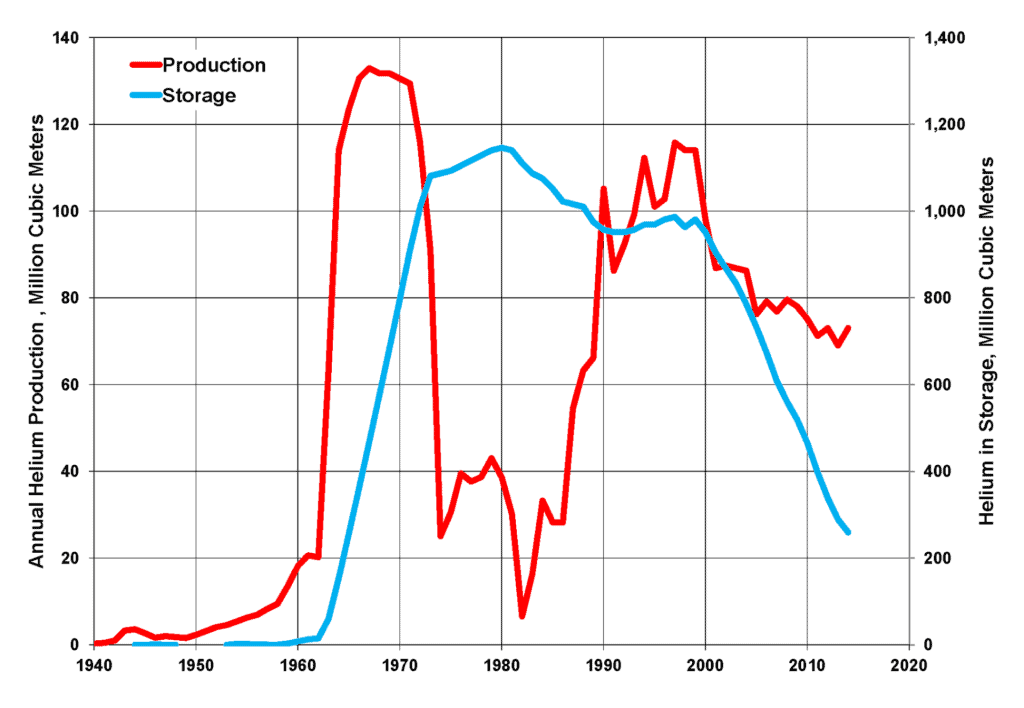Helium is the second most abundant element in the universe, but it’s not as abundant here on Earth — at least not in a form we can use.
For the past couple of decades, concerns about helium shortage have become more and more pressing. From 2011 to 2013, the helium industry faced shortfalls of 20%, and the same thing happened again in 2019, showing that this problem is far from solved.
We are running out of helium, and this won’t just mean fewer party balloons; helium is used in several important industries, including medical imaging — our MRIs don’t work without it.

Where is helium found
It was on August 18, 1868 that researchers turned their telescope towards an eclipse, discovering a then-unknown element which was called helium. Helium, it turns out, is a gas so inert and elusive that it took them several decades to isolate it in a lab (in a landmark paper published in 1920 in Nature). Since then, we’ve learned quite a bit about helium. It’s the second most abundant gas in the universe, it’s used for a wide array of scientific pursuits (including the search for the elusive Higgs Boson), and yet, it’s very elusive to get a hold of here on Earth.
Helium is exclusively mined as a byproduct of natural gas extraction. Most of the helium that is removed from natural gas is thought to form from radioactive decay of uranium and thorium in granite rocks in the Earth’s continental crust.
Helium has the smallest atomic radius of any element, so it’s very easy for it to move upward, fitting through the smallest of pores within the rocks. However, there are some rocks (such as halite, the mineral form of salt) that can block the upward migration of helium, acting as a trap. This same type of trap is also effective at trapping oil and natural gas, which are light and also tend to flow upward.
A simple way to think about it is like a layer of cake, trapped between other layers.

So helium pockets can be found where three main geological conditions are met:
- the rock basement consists of granites or granite-type rocks rich in uranium and thorium;
- there is a system of fractures or fissures that allows helium to flow towards the surface;
- the structure has an impermeable cap consisting of rocks such as halite or anhydrite.
The good thing about this is that mining helium can be done through the same rough methods as natural gas, and the gases can then be separated. However, the separation process is expensive.
Helium usually makes up a minuscule portion of natural gas, but in some areas, it can make up as much as 10% of natural gas. A helium content of at least 0.3% is considered necessary, otherwise the separation process just costs too much. Helium can also accumulate without natural gas, but it doesn’t make much economic sense to mine it — particularly because it’s so difficult to store.
Unstoppable helium
It’s extremely expensive and difficult to store helium — it just goes away, no matter what we do.
To store and transport it, it must first be cooled to a temperature of -452 degrees Fahrenheit (-270 Celsius), making it the coldest substance on the planet. But it gets even worse: even at these extremely cold temperatures, the liquid slowly evaporates away, and because of its structure, gaseous helium will escape any container we know of. It’s a noble gas, and it’s a master escape artist.
So if you want to store helium, your best bet is once again to turn to geology. At the Federal Reserve in Amarillo, helium is compressed at the surface and injected into a layer of dolomite rock, 3,000 feet (914 meters). Above these dolomite locks, there lies a layer of halite (salt) that traps the helium in place. This is the best process we have available at this moment to store helium, and as you can imagine, it’s expensive and time-consuming.

By 1995, the US had gathered a billion cubic meters of helium. However, the Congress started phasing out the reserve in 1996, as the reserve was in debt. The resulting “Helium Privatization Act of 1996” directed the reserve to sell off its helium by 2005. For comparison, the US (the world’s largest helium producer) totaled 73 million cubic meters in 2014, around 30% of global production — but still just a fraction of what was in reserve before.
Amarillo was chosen because it has the right geology and it’s suitable logistics wise, especially due to its proximity to helium-rich fields. Even in the US, there are only a few known natural gas fields that are helium-rich.

The Helium Privatization Act was just the first step, however. By 2007, it was reported that the federal government was auctioning off parts of the Amarillo Helium Plant, and the National Reserve itself was reported to be “slowly being drawn down and sold to private industry. The facility has to be fully privatized by September 2021, which adds to the uncertainty regarding the ongoing helium crisis.
In Amarillo itself, locals don’t seem to care much about it. A recent article by Laura Garcia at Express News quotes Operations Manager Barry Stoll as saying:
“Sometimes people are surprised to hear we’re still operating,” said Samuel Burton, field manager of the Amarillo office. “They thought we closed in ’96” when Congress first sought to shut down the helium reserve”
So is there a helium shortage?
The short answer is yes.
In 2017, filling up a dozen helium balloons would have set you back around $12. Today, that costs almost double. Not only have the prices for helium surged in recent years, but supply is also problematic at points.
In addition to the political and business side of things, there are very good physical reasons why there’s a helium shortage. Helium may be abundant in the universe, but here on Earth, it just floats away. The granite-type rocks that produce it aren’t all that abundant in the first place, especially under impermeable rocks that can trap it in place. So the supply side is scarce to begin with, as it requires unusual geological conditions.
There’s another problem: worldwide, the number of natural gas fields that are also rich in helium are decreasing — we’re not finding any new big ones, and ideally, natural gas consumption would also be phased out in the coming decades. Then, as mentioned, there’s the storage issue, and the uncertainty regarding the Amarillo reserve — by far the largest reserve in the world, not that there are that many global helium reserves to begin with.

Then, in the grand scheme of natural gas things, helium is little more than an afterthought. Around 97% of all the collected helium is produced as a “waste product”, during the purification of natural gas.
Reserves are also running low, while consumption is steady or even increasing. It’s not surprising then that prices and availability become problematic.

Helium demand is outpacing supply, by up to 15% according to some estimates. Many fear the privatization of the US helium reserve will create further uncertainty and cause even more chaos into an already uncertain market. The reserve is
We’re not gonna run out of helium today or tomorrow, but all the signs are pointing to a period of helium shortage. But how big a problem is that?
What is helium used for
If it were just party balloons and funny voices, there wouldn’t be that much of a problem to begin with. But things aren’t that simple with helium.
Because helium’s liquid state is the coldest of any element, it’s used in superconducting magnets, such as the ones in MRI scanners. In fact, MRI scanners can’t work without helium, although this is an area of active research. The average MRI machine utilizes around 1,700 liters of helium.
It’s not just MRIs, either. Crucial pieces of chemistry lab equipment don’t work unless they’re cooled with liquid helium. Among other things, helium is used to cool and clean out rocket engines, in physics and chemistry research (including the Large Hadron Collider), deep-sea diving, weather forecasting, cryogenics, rocket engineering, and advanced manufacturing such as computer chips and liquid crystal displays. There is no substitute for the gas, and a lack of supply can affect researchers on multiple levels, leading to a loss of research equipment and materials.

The helium shortage is no joke. In fact, given that around 10% of the current supply is used for balloons, David Cole-Hamilton, emeritus professor of chemistry at the University of St Andrews, says its use for balloons is “absurd” and should be banned.
“If you said to people, do you want a helium balloon or an MRI scan for your daughter, it’s an obvious choice,” he told the BBC.
So if we do run out of helium, it could mean real trouble, particularly considering how widespread medical imaging tools have become.
New supplies? The Earth and beyond
For many years, the US has produced more than 90% of the commercial helium in the world. A natural gas plant in Arzew, Algeria, began producing massive amounts of helium in the mid 1990s, enough to cover all of Europe’s demand. In 2004-2006, two other plants were built, one in Qatar and the other also in Algeria, making the country the second leading producer of helium.
The next 5 years are expected to bring a massive increase in the production of helium. An upcoming well from Russia as well as another one from Qatar are expected to ease shortages over most of the next decade, but that still only delays the shortage, without adequate storage facilities.
It’s noteworthy that several countries (most notably China) are also considering mining the moon for helium — but that’s not ‘normal’ helium, it’s an isotope called Helium-3 that could create nuclear fusion plants that aren’t radioactive.
What happens to helium once we (hopefully) transition to renewable energy? For now, there’s not much of a plan for that situation, and the helium shortage is being dealt with one step at a time.


